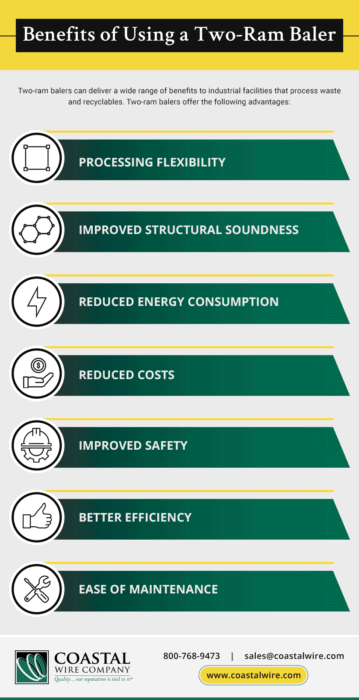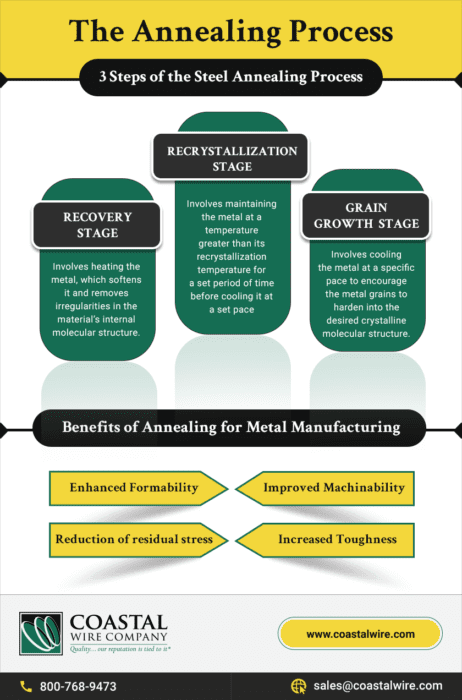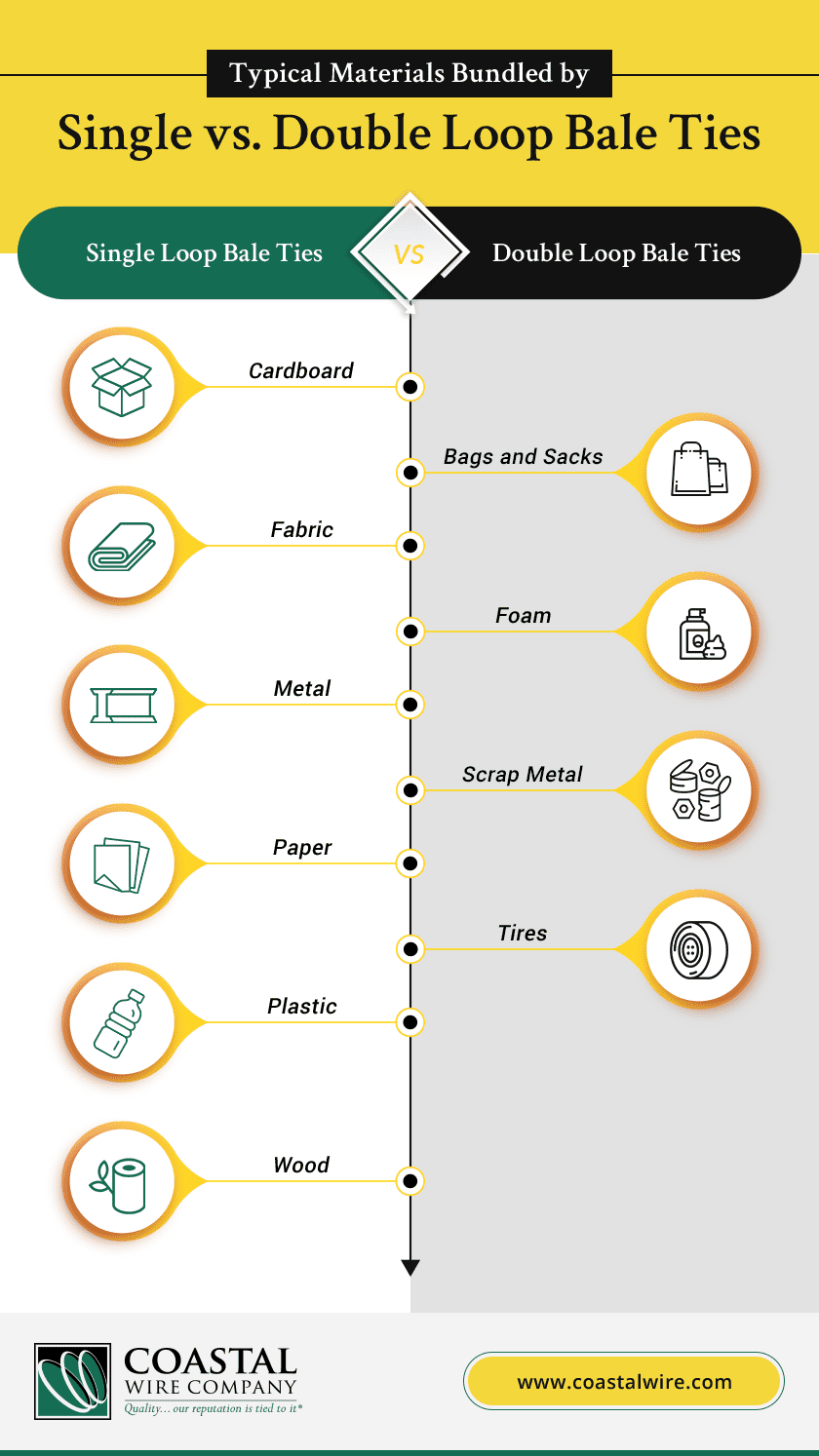Wire for Two-Ram Baler Applications
Balers provide an ideal solution for compacting waste, providing easier storage, transport, and disposal in numerous facilities and worksites. Two-ram balers have become a popular choice for a variety of commercial, industrial, and construction applications due to their increased efficiency over single-ram solutions. Two-ram balers see broad usage in solid waste processing, material recovery, recycling, distribution centers, scrap metal yards, and many other use cases.
What are Two-Ram Balers?
Sometimes called double-cylinder balers, two-ram balers use two cylinders for baling materials. The cylinders may be horizontal or vertical based on the particular setup and machine. The primary advantage of the two-ram baler is the larger size and density of the bales it creates. Two-ram balers are well-suited to baling a variety of waste materials, including:
- Cardboard
- Plastic
- Fiber
- Paper
- Textiles
- Tires
Of note, two-ram balers are actually the only choice for tire baling, as single-ram balers cannot handle the rebound from the tires.
Implementing a wire tier with a two-ram baler makes baling materials easy by securing a wire with high tensile strength to the bale after completion. A wire tier reduces the cost of baling, increases performance and reliability, and reduces downtime. High-quality wire tiers use a precisely timed torque tube to knot the wire and feature a removable parts cartridge for easy maintenance.
The Benefits of Using a Two-Ram Baler
Two-ram balers can deliver a wide range of benefits to industrial facilities that process waste and recyclables. Two-ram balers offer the following advantages:
- Processing flexibility. Two-ram balers possess a heavy and spacious chamber that is fully enclosed, allowing a diverse range of materials to be processed.
- Improved structural soundness. Two-ram balers deliver reliability and longevity thanks to a sturdy one-piece sidewall that limits failure points.
- Reduced energy consumption. Leading baler technology reduces energy consumption while increasing the efficiency and speed of the machine.
- Reduced costs. Materials require less breaking-down before being placed in the large opening of the two-ram baler. These machines can also fit more material into a single bale, reducing labor and downtime costs.
- Improved safety. Two-ram balers rely on the latest technology to ensure safer baler operation and service.
- Better efficiency. Two-ram balers increase efficiency when processing heavy materials or large volumes that would overwhelm a single-ram or manual baler.
- Ease of maintenance. Two-ram balers reduce the preparation involved in baling and can implement automatic wire tiers with variable spacing and strap counts.
Choosing the Right Wire for Your Baler Application
There are a variety of wires available for baling equipment, including:
- Black annealed wire – A soft wire that works with any baling machine. The wire is corrosion-resistant and coated with oil to reduce friction in the baler machine.
- High tensile wire – Wire made with optimal tensile strength to withstand transportation without breaking. It comes in various gauges and works well with strapper wire tiers on two-ram balers.
- Single-loop wire – Available in black annealed wire, galvanized wire, and carbon steel wire, single-loop wire is ideal for vertical balers but must be hand tied. It is also highly flexible.
- Double-loop wire – Pre-cut lengths with a bend and loop on each end. They allow workers to tie materials quickly by snapping the ends together with no twisting, making them ideal for high-volume processing.
- Box wire – A type of black annealed wire packaged by weight in 50-lb. or 100-lb. boxes. It works for all types of single-ram balers and is lightly lubricated to reduce friction and corrosion.
At Coastal Wire Co., we offer a wide range of two-ram baler wires to meet a diverse range of needs, including:
- KleenGreen Bale Ties: Available in lengths of up to 22’ and 11-14.5 gauge. Features a clean finish, increased elongation and tying ease, and decreased breakage.
- Black Annealed Bale Ties: Available in 10-21’ lengths and 11-14 gauge. Can be palletized for stackable shipping and storage.
- Galvanized Bale Ties: Available in 10-22’ lengths and 11-14.5 gauge. Can also be palletized.
About Coastal Wire Company
Two-ram balers can deliver various benefits to industrial facilities that need to process waste and recyclables. They can also implement wire tiers for automated bale tying according to pre-set specifications. Coastal Wire Company has been providing innovative baling wire solutions to recycling centers and other industrial facilities since 1978. We can deliver a variety of high-quality wire solutions for two-ram balers of all makes.
The Coastal Wire Company product line now also includes an innovative, heavy-duty MDC 24/7 Two Ram Wire Strapper to save wire, time, and money. The MDC 24/7 offers benefits such as:
- Shortening average knot length by more than two inches to save wire
- 95% knot strength
- Four driven reversible wheels with built-in wear gauges
- Wear parts that are replaceable in 10 minutes
- Automatic lubrication
- Right-hand and left-hand feed options
- A floating gripper
- Custom sizes
Contact us or request information today for help identifying the ideal baling wire solution for your equipment.
The Process of Steel Annealing
Annealing is a heat treatment used to enhance the ductility and hardness of metals to make them easier to fabricate into finished products. Manufacturers heat the metal to a point above its recrystallization temperature for a set period of time and then cool it at a specific rate to establish the desired molecular structure and chemical properties. Different metals are treated in ways specific to their molecular makeup and intended use. For example, iron, steel, and other ferrous metals are allowed to cool slowly at room temperature, whereas other metals may be quickly air-cooled or quenched in water.
The annealing process offers a variety of benefits for metal manufacturing, including:
- Enhanced formability
- Improved machinability
- Reduction of residual stress
- Increased toughness
Annealing also reduces the overall brittleness of ferrous metals and alters the crystalline structure to enhance magnetic and electrical properties.
What are the 3 Steps of the Steel Annealing Process?
While the process can be modified slightly for different formulations and applications, annealing carbon steel and other steel blends always follows the following three steps:
- Recovery Stage. Recovery involves heating the metal, which softens it and removes irregularities in the material’s internal molecular structure. By removing internal stresses, the metal recovers its original characteristics, including electrical conductivity and thermal expansion.
- Recrystallization Stage. The recrystallization stage involves maintaining the metal at a temperature greater than its recrystallization temperature for a set period of time before cooling it at a set pace. This encourages the growth of new stress-free crystals.
- Grain Growth Stage. This third stage of annealing involves cooling the metal at a specific pace to encourage the metal grains to harden into the desired crystalline molecular structure. Depending on the intended results, this can involve cooling at room temperature; air cooling; or quenching in water, saltwater, or oil. Steel is typically quenched to enhance hardness.
Coastal’s Batch Steel Annealing Process
At Coastal Wire, we pride ourselves on using the latest annealing technology to produce superior quality annealed steel. Our bell-type annealing furnaces provide consistent annealing throughout the workpiece, without any weak spots. Unlike open-air heating and rapid cooling methods, our highly regulated annealing process does not introduce any inconsistencies or variations in the final product.
Coastal Wire uses batch annealing to heat our wires. The process helps to ensure that our wires exhibit the highest degree of strength and durability while offering the expansion and elongation necessary for heavy-duty baling applications. More traditional strand annealing only heats steel wire for a few minutes before rapidly cooling it, making for a less durable, less consistent material. Our wire, on the other hand, is heated in batches for several hours and then allowed to cool slowly. This creates a typical elongation of 25%, which significantly reduces the potential for wire breakage during automatic baling operations.
High-Quality Wires for Long-Term Performance
At Coastal Wire, we are committed to ensuring that our customers receive only the highest quality wire on the market. We adhere to a no-shortcut philosophy when it comes to our annealing process. Our longer annealing process ensures that your baling wire is durable and break-resistant, so you can rest assured that your materials will get from point A to point B without issue. In fact, we are so confident in our annealed wires that if they break, we will replace them for free.
With more than 40 years of experience manufacturing fully annealed baling wire, we know that every application has different needs. Our baling wire is available in 50 lb and 100 lb box coils for automatic balers, as well as single-loop bale ties for hand baling. All of our products are subject to extensive metallurgical testing throughout the manufacturing process, from direct approval of rod purchases through shipping. We also offer expert troubleshooting, testing, and consulting services to help you solve tying problems and determine whether the wire you’re using is up to standard.
At Coastal Wire, our reputation speaks for itself, with the lowest rate of wire breakage in the industry and verified quality over other baling wire manufacturers. To learn more about our batch annealing process and baling wire solutions, contact us today or submit a request for information.
Single vs. Double Loop Bale Ties
Bale ties—also referred to as wire ties—are pieces of wire used to bundle material together. They are available in numerous variations to suit different baling applications. Two of the most commonly used types are single loop bale ties and double loop bale ties. Below, we provide an overview of these two products, highlighting their unique design, advantages, applications, and selection considerations to help readers determine which one—if any—is right for their needs.
What Are Single Loop Bale Ties?
Single loop bale ties are baling wires with a single loop on one end. They are made from strong but flexible materials—such as black annealed wire or galvanized wire—which enables them to wrapped tightly and securely around bundles.
Advantages of Single Loop Bale Ties
The main advantage of single loop bale ties is their versatility. They can be manually cut to virtually any length. This quality enables users to tailor the tie to the exact needs of their particular baling application. Additionally, it helps them minimize the amount of waste produced since they can carefully control material usage.
Typical Materials Bundled by Single Loop Bale Ties
Typical materials that are bundled together by single loop bale ties include:
- Cardboard
- Fabric
- Metal
- Paper
- Plastic
- Wood
Key Considerations When Using Single Loop Bale Ties
If you decide to use single loop bale ties for your baling operations, you should consider the following factors:
- Wire gauge. Single loop bale ties come in a variety of gauges. The ties you choose should be appropriately sized for your baling equipment. Otherwise, it may be difficult to bundle material.
- Wire strength. The tensile strength of a wire is indicative of its ability to withstand pressure and tension. If it is not strong enough to handle the conditions of the application, it may snap.
What Are Double Loop Bale Ties?
Double loop bale ties are precut baling wires that have loops on both ends. Similar to single loop bale ties, they are made from durable and flexible materials, like black annealed, galvanized, or bright steel.
Advantages of Double Loop Bale Ties
The main advantage of double loop bale ties is their ease of use. Their unique design eliminates the need for the user to bend the wire. They can form bundles simply by hooking the two loops of the tie together and then twisting the wire in a single direction. This simple process can increase significantly improve the work efficiency of baling operations.
Typical Materials Bundled by Double Loop Bale Ties
Typical materials that are bundled together by double loop bale ties include:
- Bags and sacks
- Foam
- Scrap metal
- Tires
Key Considerations When Using Double Loop Bale Ties
If you decide to use double loop bale ties for your baling operations, you need to consider the same factors as if you decided to use single loop bale ties (e.g., wire gauge and wire strength). Additionally, you should keep in mind the following:
- The loops need to be perfectly formed. Otherwise, they may not link or connect securely.
- The ties need to be the same length and strength. Otherwise, the ties may not stretch at the same rate, which can cause bale breakage or distortion.
Single and Double Loop Bale Ties From Coastal Wire
Want more information on single and double loop bale ties? Ask the experts at Coastal Wire! As a premier supplier of quality wire products, including bale ties, we have what it takes to answer and address any questions or concerns you may have about these two products.
Looking for bales ties you can trust in your baling operations? We’ve got you covered. Request a quote for product and pricing details.




